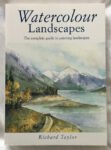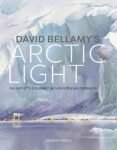At the time I bought this book I was only painting landscapes and my artwork…

David Bellamy’s Complete Guide To Landscapes – Book Review
Things have been a bit quiet over the last couple of days as I’ve been reading this 288 page paperback monster. It’s one of those books that’s been created by smashing together a number of smaller, older books. In this case the four original books were David Bellamy’s Skies, Light And Atmosphere (80 pages), David Bellamy’s Mountains & Moorlands In Watercolour (80 pages), David Bellamy’s Seas & Shorelines In Watercolour (96 pages) and David Bellamy’s Landscapes Through The Seasons In Watercolour (96 pages). That adds up to 352 pages, so we’ve lost 64 pages. A lot of this will be from introductory chapters, but there are also a couple of demonstrations that have been left out, demonstrations that I suspect would have made the book a bit repetitive but we’ll get to that later.
Structure–wise, at a macro level, we have:
- About 35 pages of introduction, including materials and composition
- About 20 pages on skies
- About 40 pages on light and atmosphere. I already like how Search Press have already divided that first book in two, making this book look less like four books stuck together with little thought.
- About 45 pages on moorlands and mountains
- About 70 pages on seas and shorelines
- About 80 pages on the four seasons
On a micro level, once we’re out of the introduction and into specifics, David’s way of teaching us is via:
- General advice. As well as specific advice on (studio) painting, there’s lots of practical advice about plein air painting and how to overcome the difficulties of painting in the cold, on a mountain, at sea, etc
- Detailed demonstrations. There are 14 of these in the book, generally with about 30 steps. This sounds a lot but David uses a lot of colours in his steps and takes a lot of care over all sorts of tiny tweaks and details. Where I might use three colours in a 3–5 step process, David’s using 8–10 colours in a 20–40 step process. Where I’m Jamie Oliver, David’s a Masterchef contestant and that’s not a criticism. And I liked how one of the last steps in some of the demos was where David would take a step back from the painting and identify a small compositional tweak that would push it up a level.
- Shorter demonstrations. Because sometimes two or three steps is all it takes to get the lesson across.
- And finally, photos of lots of individual paintings with paragraphs of text next to them talking about how David used a particular technique or compositional idea in them. I learn most from examples like this and there were a lot of them in this book, making it feel pretty dense on content to me.
Anyway, let’s talk through those five chapters of specifics. First up is the chapter on skies. Not much to say here. Lots of examples of lots of different skies. One long demonstration included, just like in the original book. It felt like a lot more than 20 pages.
The same applies to the chapter on light and atmosphere. Lots of example and lots more to learn than I expected. A lot of the ideas in this chapter were around compositional decisions to be made at the start of a painting. Only one of the two demos in the original book is included here: a painting of a waterfall has been left out and, what with there being another waterfall painting coming up later, this feels like a smart decision.
What’s next? Moorlands and mountains. Still crammed with ideas, including little sections on trees, water, rocks, mountains, glaciers. Some advice on buildings from the original book has disappeared but is probably now in that introductory chapter instead. Three of the four demos from the original book are included here but the fourth will pop up later.
Then it’s seas and seascapes. We start to get more general advice here, on cliffs, beaches, waves, rocks, boats, harbours, figures, birds, pen & wash, composition and two point perspective (!). Three of the four demos from the original book are included here but it looks like the one left out was quite short. It seems that when David got around to writing this book, he was starting to extend his palette from quite traditional colours into hipster colours like those in the Daniel Smith Primatek range. I found myself looking back at the introduction to where David talked about his colour range and found that he recommended ten colours plus white gouache but then listed some more colours that we might be interested in adding once we were confident using that first set of colours. Very smoothly done. Someone’s made a big effort to turn this into a single book that hangs together.
And finally we have the chapter on the four seasons. For someone like David with a huge bibliography of books behind him on specific subjects, releasing a book on the four seasons looked to me like a money spinner, looking to make more money from the knitting pattern brigade, hungry for more demos they could copy from an author that they like but who has probably already taught them everything they can. So I was surprised when there was still plenty to learn here. Mainly about summer trees, summer foregrounds, snow and the difference between spring and summer colours. Not so much content on autumn but a book about three seasons would have been silly. Of the six demos on the original book, five appear here, including one of a waterfall. The sixth demo, another waterfall, has been left out, but is replaced by an autumn moorland scene that’s been moved from the moorlands and mountains book.
By the end of the book I was feeling knackered. Search Press might have done a great job making this look like a single book but it felt like I’d read four books. For anyone not feeling bound to write up notes or to write a review of this book, I’d advise treating this like four books, to be read separately. Because this book has a really high tip density. It reminded me of Liz Chaderton‘s books, all fish and no batter. It’s a relentless barrage of tips. A lot of these tips are given in single paragraphs next to photos of completed paintings, which I know the knitting pattern brigade will hate but which absolutely works for me. Maybe 80 page books can’t afford to waste any time and have to smash the ball around the park whereas 200+ page books can take their time to build a steady innings. That would explain how I’m feeling. I’m not sure I’d make it through the day if I went to a test match and saw a side bash out 800 runs in 80 overs by batting like a T20 team.
Voice–wise, David’s not the most passionate writer (at least in this book: Arctic Light is another matter!) but definitely not the most boring either. Instead, what comes through in his words is honesty, humility and a real interest in passing on his wisdom and not holding anything back to include in future books. What’s important is that it’s a voice I want to hear.
Overall, for the sheer number of ideas in here, this has to get the five palettes. If I only remember 20% of the ideas in this book, that’s a lot and I’ll be able to keep coming back to the book and learning more. And whisper it but even the knitting pattern brigade will probably enjoy copying the demos. Well done Mr. Bellamy.
🎨🎨🎨🎨🎨
You can find this book and more reviews of it at Amazon UK here. As an Amazon Associate, I earn commission from qualifying purchases but this costs absolutely nothing extra to you.








Leave a Reply